Analysis of Organizational Development Theories and Team Development
VerifiedAdded on 2022/12/15
|13
|3181
|220
Report
AI Summary
This report provides a comprehensive analysis of organizational development theories, focusing on their applications and implications for team development. It begins by defining organizational development and its evolution, then delves into various theories, including Systems Theory, Action Research Theory, and Dialogic Organizational Development Theory, with a particular emphasis on the Strength Based Theory. The report incorporates evidence from CliftonStrengths assessments of team members to draw conclusions about communication gaps, healthy competition, and the need for maximizing individual strengths. Recommendations are provided to enhance team performance, improve communication, and foster a positive work environment. The report uses Tuckman’s group development model, which includes forming, storming, norming, and performing stages to explain team dynamics. The report concludes with a call to action, urging readers to leverage the insights gained to optimize organizational effectiveness and promote a thriving workplace culture. The report is a student contribution to Desklib, a platform providing AI-based study tools.
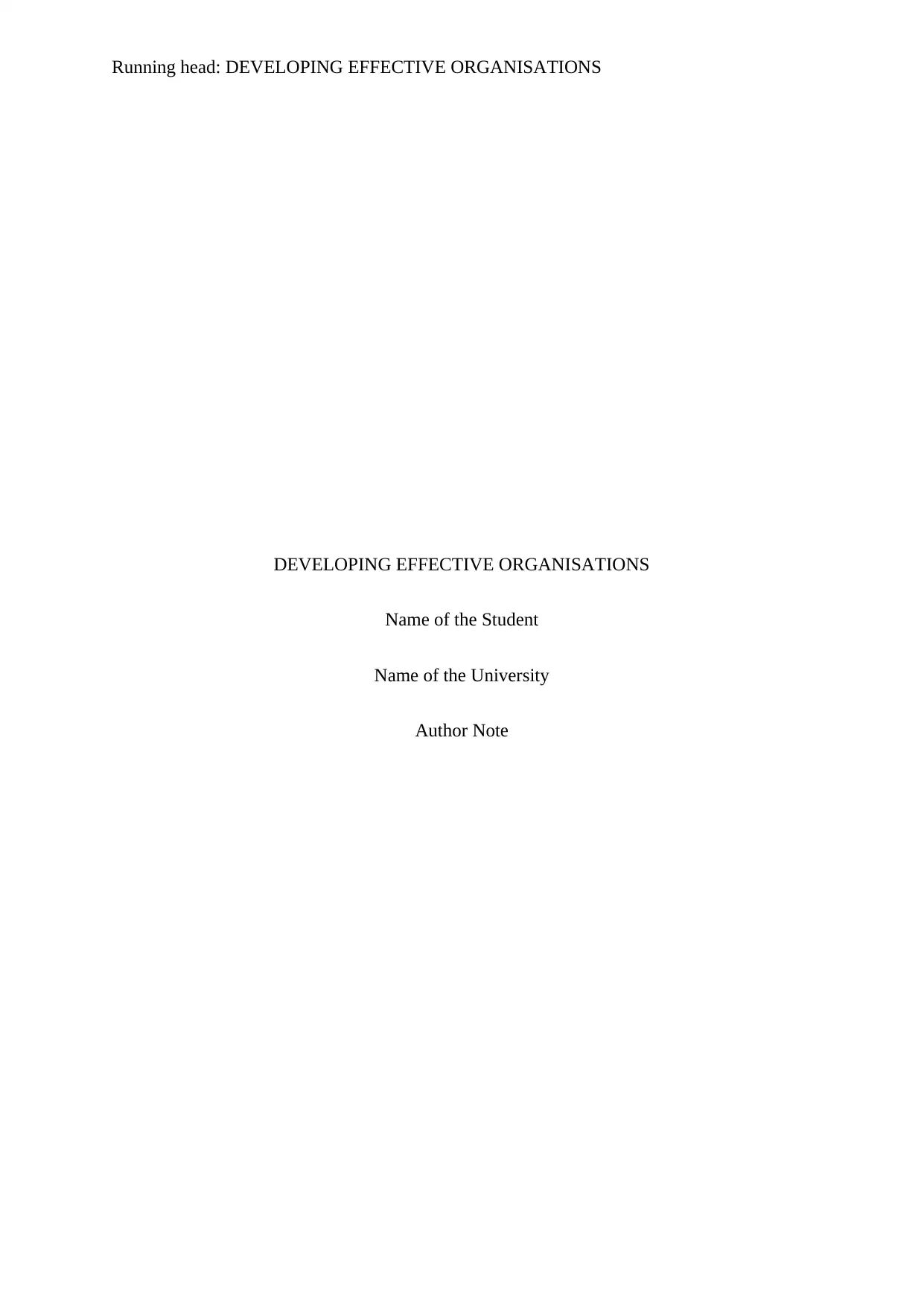
Running head: DEVELOPING EFFECTIVE ORGANISATIONS
DEVELOPING EFFECTIVE ORGANISATIONS
Name of the Student
Name of the University
Author Note
DEVELOPING EFFECTIVE ORGANISATIONS
Name of the Student
Name of the University
Author Note
Paraphrase This Document
Need a fresh take? Get an instant paraphrase of this document with our AI Paraphraser
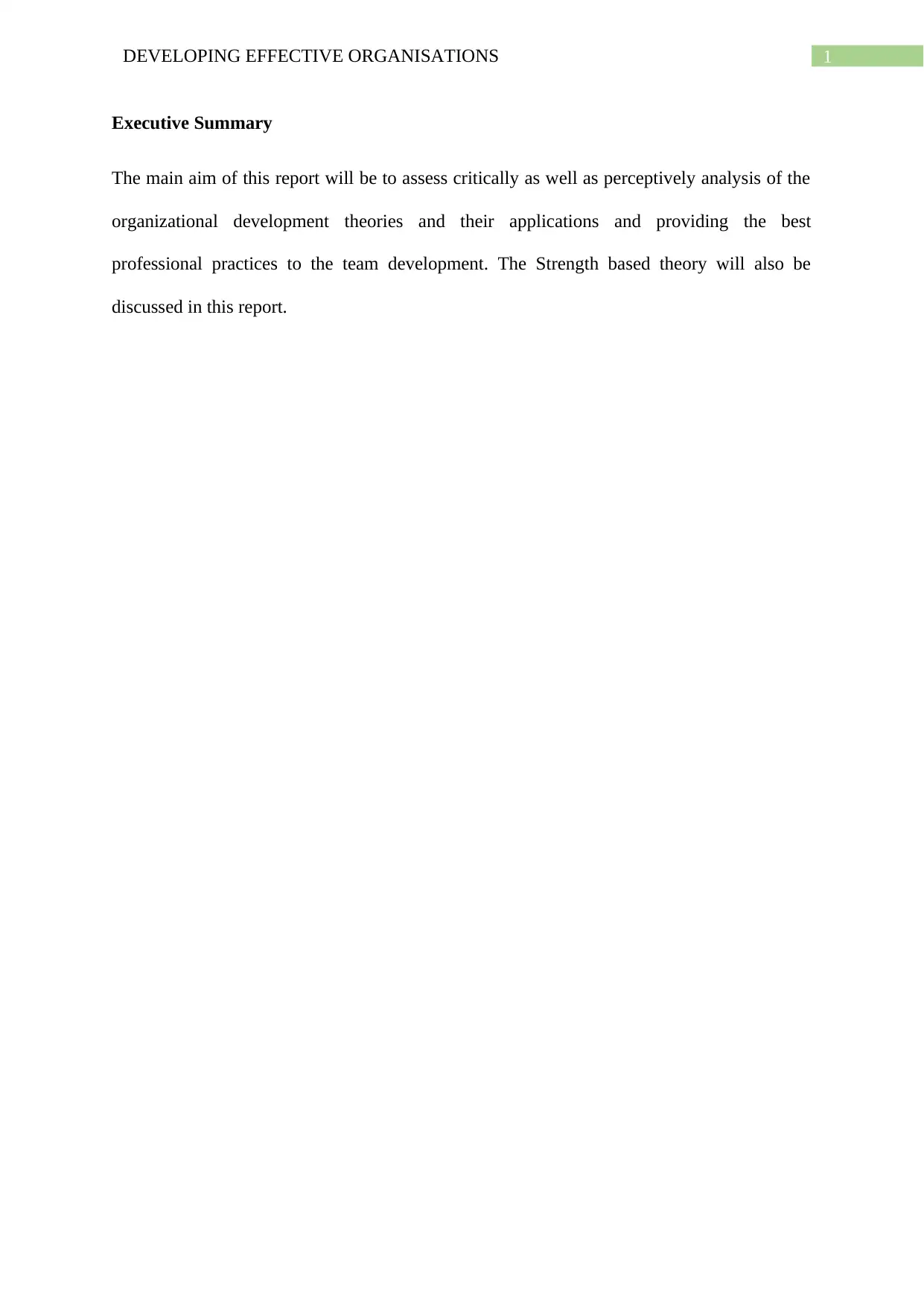
1DEVELOPING EFFECTIVE ORGANISATIONS
Executive Summary
The main aim of this report will be to assess critically as well as perceptively analysis of the
organizational development theories and their applications and providing the best
professional practices to the team development. The Strength based theory will also be
discussed in this report.
Executive Summary
The main aim of this report will be to assess critically as well as perceptively analysis of the
organizational development theories and their applications and providing the best
professional practices to the team development. The Strength based theory will also be
discussed in this report.
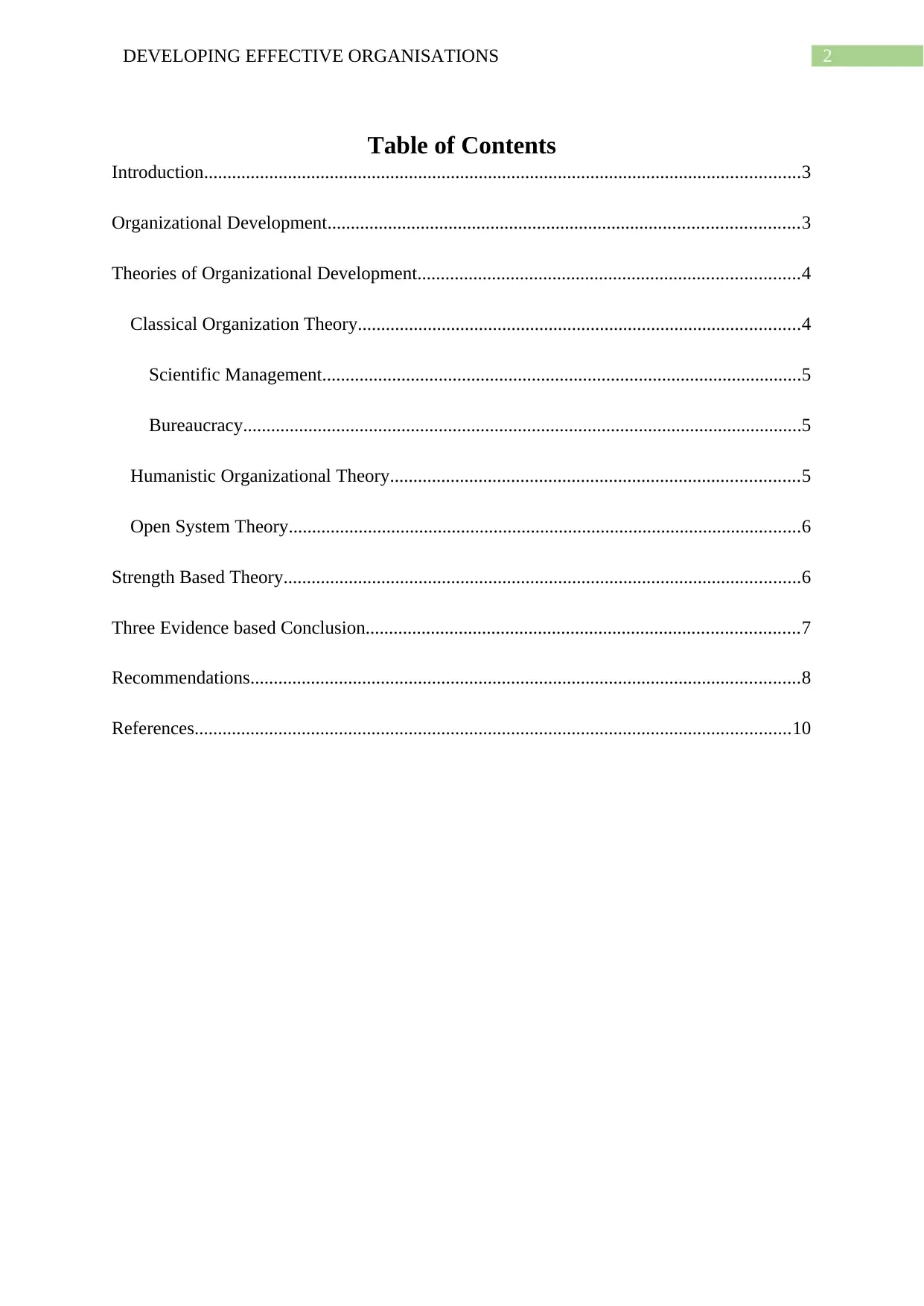
2DEVELOPING EFFECTIVE ORGANISATIONS
Table of Contents
Introduction................................................................................................................................3
Organizational Development.....................................................................................................3
Theories of Organizational Development..................................................................................4
Classical Organization Theory...............................................................................................4
Scientific Management.......................................................................................................5
Bureaucracy........................................................................................................................5
Humanistic Organizational Theory........................................................................................5
Open System Theory..............................................................................................................6
Strength Based Theory...............................................................................................................6
Three Evidence based Conclusion.............................................................................................7
Recommendations......................................................................................................................8
References................................................................................................................................10
Table of Contents
Introduction................................................................................................................................3
Organizational Development.....................................................................................................3
Theories of Organizational Development..................................................................................4
Classical Organization Theory...............................................................................................4
Scientific Management.......................................................................................................5
Bureaucracy........................................................................................................................5
Humanistic Organizational Theory........................................................................................5
Open System Theory..............................................................................................................6
Strength Based Theory...............................................................................................................6
Three Evidence based Conclusion.............................................................................................7
Recommendations......................................................................................................................8
References................................................................................................................................10
⊘ This is a preview!⊘
Do you want full access?
Subscribe today to unlock all pages.

Trusted by 1+ million students worldwide
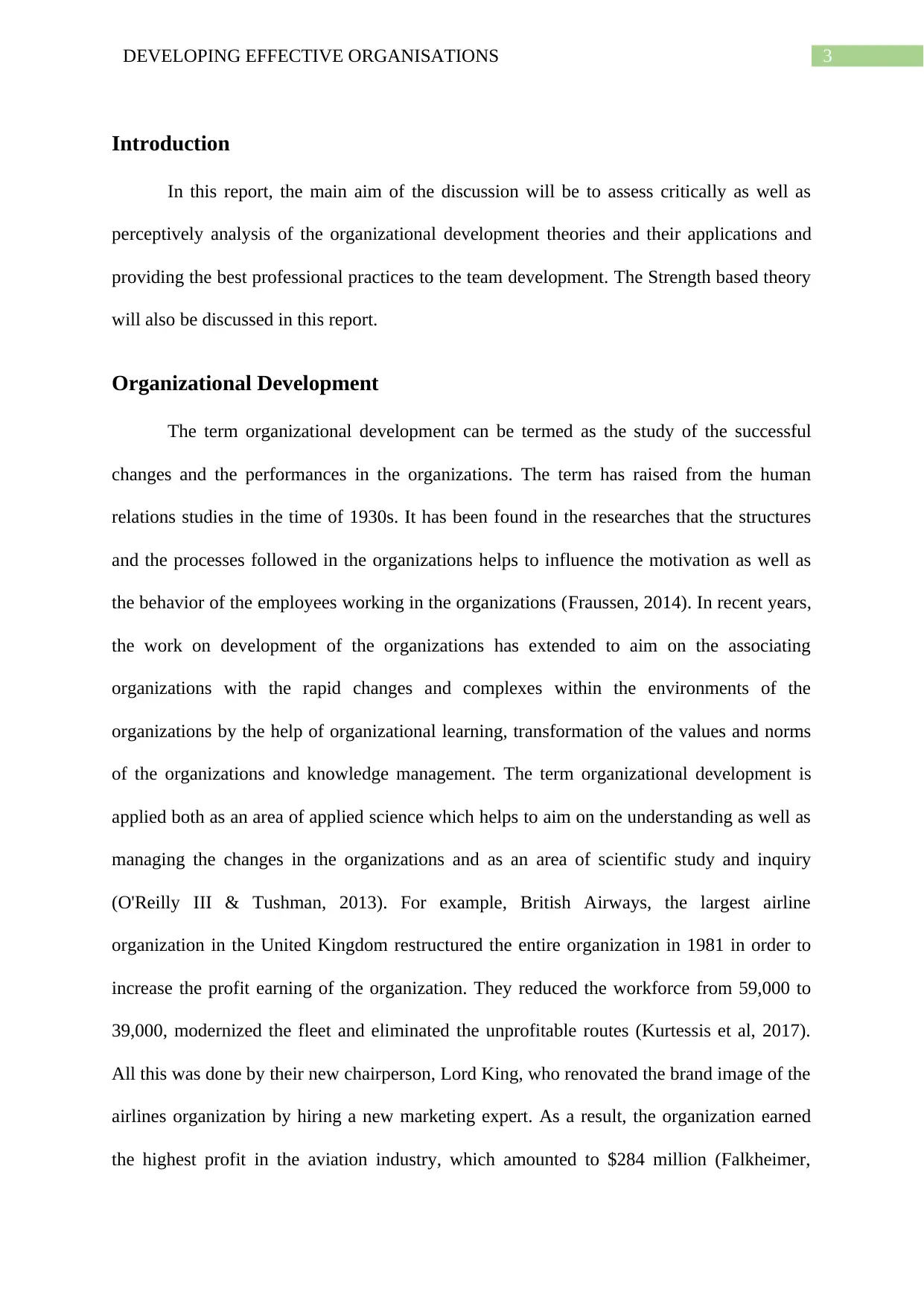
3DEVELOPING EFFECTIVE ORGANISATIONS
Introduction
In this report, the main aim of the discussion will be to assess critically as well as
perceptively analysis of the organizational development theories and their applications and
providing the best professional practices to the team development. The Strength based theory
will also be discussed in this report.
Organizational Development
The term organizational development can be termed as the study of the successful
changes and the performances in the organizations. The term has raised from the human
relations studies in the time of 1930s. It has been found in the researches that the structures
and the processes followed in the organizations helps to influence the motivation as well as
the behavior of the employees working in the organizations (Fraussen, 2014). In recent years,
the work on development of the organizations has extended to aim on the associating
organizations with the rapid changes and complexes within the environments of the
organizations by the help of organizational learning, transformation of the values and norms
of the organizations and knowledge management. The term organizational development is
applied both as an area of applied science which helps to aim on the understanding as well as
managing the changes in the organizations and as an area of scientific study and inquiry
(O'Reilly III & Tushman, 2013). For example, British Airways, the largest airline
organization in the United Kingdom restructured the entire organization in 1981 in order to
increase the profit earning of the organization. They reduced the workforce from 59,000 to
39,000, modernized the fleet and eliminated the unprofitable routes (Kurtessis et al, 2017).
All this was done by their new chairperson, Lord King, who renovated the brand image of the
airlines organization by hiring a new marketing expert. As a result, the organization earned
the highest profit in the aviation industry, which amounted to $284 million (Falkheimer,
Introduction
In this report, the main aim of the discussion will be to assess critically as well as
perceptively analysis of the organizational development theories and their applications and
providing the best professional practices to the team development. The Strength based theory
will also be discussed in this report.
Organizational Development
The term organizational development can be termed as the study of the successful
changes and the performances in the organizations. The term has raised from the human
relations studies in the time of 1930s. It has been found in the researches that the structures
and the processes followed in the organizations helps to influence the motivation as well as
the behavior of the employees working in the organizations (Fraussen, 2014). In recent years,
the work on development of the organizations has extended to aim on the associating
organizations with the rapid changes and complexes within the environments of the
organizations by the help of organizational learning, transformation of the values and norms
of the organizations and knowledge management. The term organizational development is
applied both as an area of applied science which helps to aim on the understanding as well as
managing the changes in the organizations and as an area of scientific study and inquiry
(O'Reilly III & Tushman, 2013). For example, British Airways, the largest airline
organization in the United Kingdom restructured the entire organization in 1981 in order to
increase the profit earning of the organization. They reduced the workforce from 59,000 to
39,000, modernized the fleet and eliminated the unprofitable routes (Kurtessis et al, 2017).
All this was done by their new chairperson, Lord King, who renovated the brand image of the
airlines organization by hiring a new marketing expert. As a result, the organization earned
the highest profit in the aviation industry, which amounted to $284 million (Falkheimer,
Paraphrase This Document
Need a fresh take? Get an instant paraphrase of this document with our AI Paraphraser
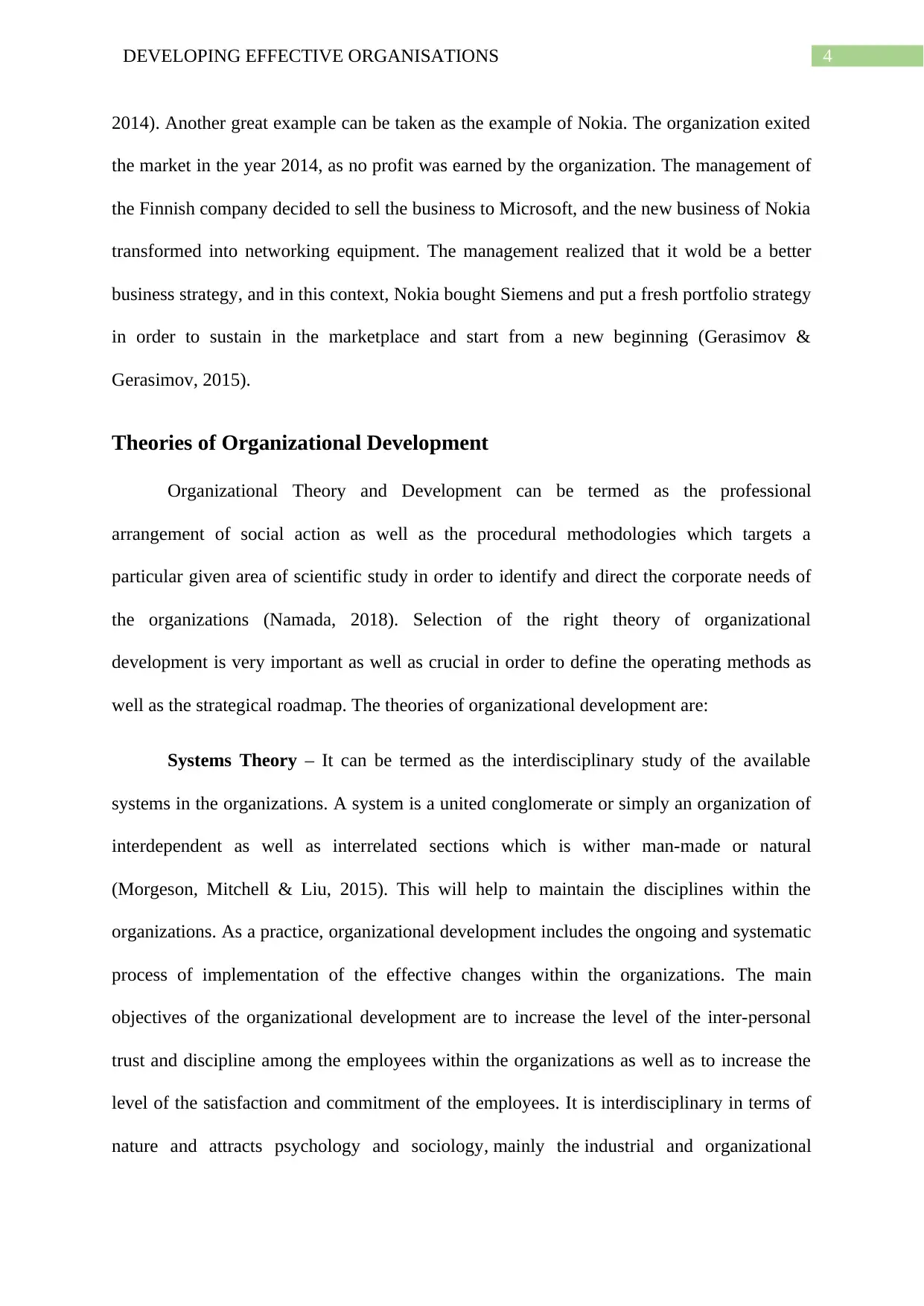
4DEVELOPING EFFECTIVE ORGANISATIONS
2014). Another great example can be taken as the example of Nokia. The organization exited
the market in the year 2014, as no profit was earned by the organization. The management of
the Finnish company decided to sell the business to Microsoft, and the new business of Nokia
transformed into networking equipment. The management realized that it wold be a better
business strategy, and in this context, Nokia bought Siemens and put a fresh portfolio strategy
in order to sustain in the marketplace and start from a new beginning (Gerasimov &
Gerasimov, 2015).
Theories of Organizational Development
Organizational Theory and Development can be termed as the professional
arrangement of social action as well as the procedural methodologies which targets a
particular given area of scientific study in order to identify and direct the corporate needs of
the organizations (Namada, 2018). Selection of the right theory of organizational
development is very important as well as crucial in order to define the operating methods as
well as the strategical roadmap. The theories of organizational development are:
Systems Theory – It can be termed as the interdisciplinary study of the available
systems in the organizations. A system is a united conglomerate or simply an organization of
interdependent as well as interrelated sections which is wither man-made or natural
(Morgeson, Mitchell & Liu, 2015). This will help to maintain the disciplines within the
organizations. As a practice, organizational development includes the ongoing and systematic
process of implementation of the effective changes within the organizations. The main
objectives of the organizational development are to increase the level of the inter-personal
trust and discipline among the employees within the organizations as well as to increase the
level of the satisfaction and commitment of the employees. It is interdisciplinary in terms of
nature and attracts psychology and sociology, mainly the industrial and organizational
2014). Another great example can be taken as the example of Nokia. The organization exited
the market in the year 2014, as no profit was earned by the organization. The management of
the Finnish company decided to sell the business to Microsoft, and the new business of Nokia
transformed into networking equipment. The management realized that it wold be a better
business strategy, and in this context, Nokia bought Siemens and put a fresh portfolio strategy
in order to sustain in the marketplace and start from a new beginning (Gerasimov &
Gerasimov, 2015).
Theories of Organizational Development
Organizational Theory and Development can be termed as the professional
arrangement of social action as well as the procedural methodologies which targets a
particular given area of scientific study in order to identify and direct the corporate needs of
the organizations (Namada, 2018). Selection of the right theory of organizational
development is very important as well as crucial in order to define the operating methods as
well as the strategical roadmap. The theories of organizational development are:
Systems Theory – It can be termed as the interdisciplinary study of the available
systems in the organizations. A system is a united conglomerate or simply an organization of
interdependent as well as interrelated sections which is wither man-made or natural
(Morgeson, Mitchell & Liu, 2015). This will help to maintain the disciplines within the
organizations. As a practice, organizational development includes the ongoing and systematic
process of implementation of the effective changes within the organizations. The main
objectives of the organizational development are to increase the level of the inter-personal
trust and discipline among the employees within the organizations as well as to increase the
level of the satisfaction and commitment of the employees. It is interdisciplinary in terms of
nature and attracts psychology and sociology, mainly the industrial and organizational

5DEVELOPING EFFECTIVE ORGANISATIONS
psychology, as well as the theories of learning, motivation and personality (Morgeson,
Mitchell & Liu, 2015).
Action Research Theory – This theory involves the active participation in a change
situation, mainly through an existing company. It can be undertaken by larger companies,
with the goal to improve the strategies, knowledge and practices of the company (Morgeson,
Mitchell & Liu, 2015). It has been found that organizational development helps to challenge
the problems rather neglecting them and to effectively and efficiently manage the conflicts. It
helps to increase the collaboration and cooperation among the employees of the organizations
as well as to increase the problem-solving within the organizations. So, active participation in
the change situation will help to adjust with the fresh organizational development, which will
further improve the work culture and the business operations of those organizations
(Morgeson, Mitchell & Liu, 2015).
Dialogic Organizational Development Theory – This theory can be stated as the
next step in the development of the theory of organizational theory, which includes the
thinking of the companies as organisms which are able to adapt to their surroundings to
companies as conversations the results related to the actions of the group, individual and
company from creation of the self-organizing and socially constructed realities and sustained
by the current stories, narratives and conversations through which the people prepare
meaningful experiences (Morgeson, Mitchell & Liu, 2015).
Among the above discussed organizational development theories, the dialogic
organizational development theory will help to develop the performances of the team
members, as it will help to adapt to the changes according to the surrounding situations of the
organizations. It takes into accounts the overall results of the individual as well as the group,
psychology, as well as the theories of learning, motivation and personality (Morgeson,
Mitchell & Liu, 2015).
Action Research Theory – This theory involves the active participation in a change
situation, mainly through an existing company. It can be undertaken by larger companies,
with the goal to improve the strategies, knowledge and practices of the company (Morgeson,
Mitchell & Liu, 2015). It has been found that organizational development helps to challenge
the problems rather neglecting them and to effectively and efficiently manage the conflicts. It
helps to increase the collaboration and cooperation among the employees of the organizations
as well as to increase the problem-solving within the organizations. So, active participation in
the change situation will help to adjust with the fresh organizational development, which will
further improve the work culture and the business operations of those organizations
(Morgeson, Mitchell & Liu, 2015).
Dialogic Organizational Development Theory – This theory can be stated as the
next step in the development of the theory of organizational theory, which includes the
thinking of the companies as organisms which are able to adapt to their surroundings to
companies as conversations the results related to the actions of the group, individual and
company from creation of the self-organizing and socially constructed realities and sustained
by the current stories, narratives and conversations through which the people prepare
meaningful experiences (Morgeson, Mitchell & Liu, 2015).
Among the above discussed organizational development theories, the dialogic
organizational development theory will help to develop the performances of the team
members, as it will help to adapt to the changes according to the surrounding situations of the
organizations. It takes into accounts the overall results of the individual as well as the group,
⊘ This is a preview!⊘
Do you want full access?
Subscribe today to unlock all pages.

Trusted by 1+ million students worldwide

6DEVELOPING EFFECTIVE ORGANISATIONS
along with taking into action of the company. Through this, all the people would be
benefitted with the experiences gathered by the people (Harvey et al, 2014).
Strength Based Theory
This theory has its foundation laid in the social work. It can be termed as the work-
practice theory which aims on the self-determination and strength of an individual in the
workplace. This type of approach helps to build the strength of the clients of the
organizations, particularly viewing them as flexible and resourceful when the situations are in
adverse conditions (Wei, Yi & Guo, 2014). Another unique feature of this approach is that it
is fully client led and focused on the outcomes in the future set of strengths of the individual.
This theory is largely dependent on the emotional and thought process of the individual. This
approach allows to open the value identification and assembling of the strengths and
capacities of the individual in the course of alteration. For example, many Human Resource
Managers conduct the performance appraisals on the employees in the modern corporate
world (Wei, Yi & Guo, 2014). These appraisals help to benefit the employees as well as their
supervisors, and the overall flow of that organization. Apart from this, seeking for support
and attention for certain clients is a huge task and this should be recognized as a strength. It is
important to enable an individual in order to build bold relationships with their friends and
families. Another major way to enable the client of an organization is to remind them in order
to utilize the resources of their organization as well as using the flexibility and strength in
order to tackle any kind of challenges (Schmiedel, Vom Brocke & Recker, 2014).
In context of these, Tuckman’s group development can also be discussed. It includes
the forming, storming, norming and performing models. In the forming part, the team meets
and studies about the challenges and opportunities, after that agrees the goals and begin to
tackle the tasks (Donaldson, Qiu & Luo, 2013). In the storming part, the team starts to
along with taking into action of the company. Through this, all the people would be
benefitted with the experiences gathered by the people (Harvey et al, 2014).
Strength Based Theory
This theory has its foundation laid in the social work. It can be termed as the work-
practice theory which aims on the self-determination and strength of an individual in the
workplace. This type of approach helps to build the strength of the clients of the
organizations, particularly viewing them as flexible and resourceful when the situations are in
adverse conditions (Wei, Yi & Guo, 2014). Another unique feature of this approach is that it
is fully client led and focused on the outcomes in the future set of strengths of the individual.
This theory is largely dependent on the emotional and thought process of the individual. This
approach allows to open the value identification and assembling of the strengths and
capacities of the individual in the course of alteration. For example, many Human Resource
Managers conduct the performance appraisals on the employees in the modern corporate
world (Wei, Yi & Guo, 2014). These appraisals help to benefit the employees as well as their
supervisors, and the overall flow of that organization. Apart from this, seeking for support
and attention for certain clients is a huge task and this should be recognized as a strength. It is
important to enable an individual in order to build bold relationships with their friends and
families. Another major way to enable the client of an organization is to remind them in order
to utilize the resources of their organization as well as using the flexibility and strength in
order to tackle any kind of challenges (Schmiedel, Vom Brocke & Recker, 2014).
In context of these, Tuckman’s group development can also be discussed. It includes
the forming, storming, norming and performing models. In the forming part, the team meets
and studies about the challenges and opportunities, after that agrees the goals and begin to
tackle the tasks (Donaldson, Qiu & Luo, 2013). In the storming part, the team starts to
Paraphrase This Document
Need a fresh take? Get an instant paraphrase of this document with our AI Paraphraser
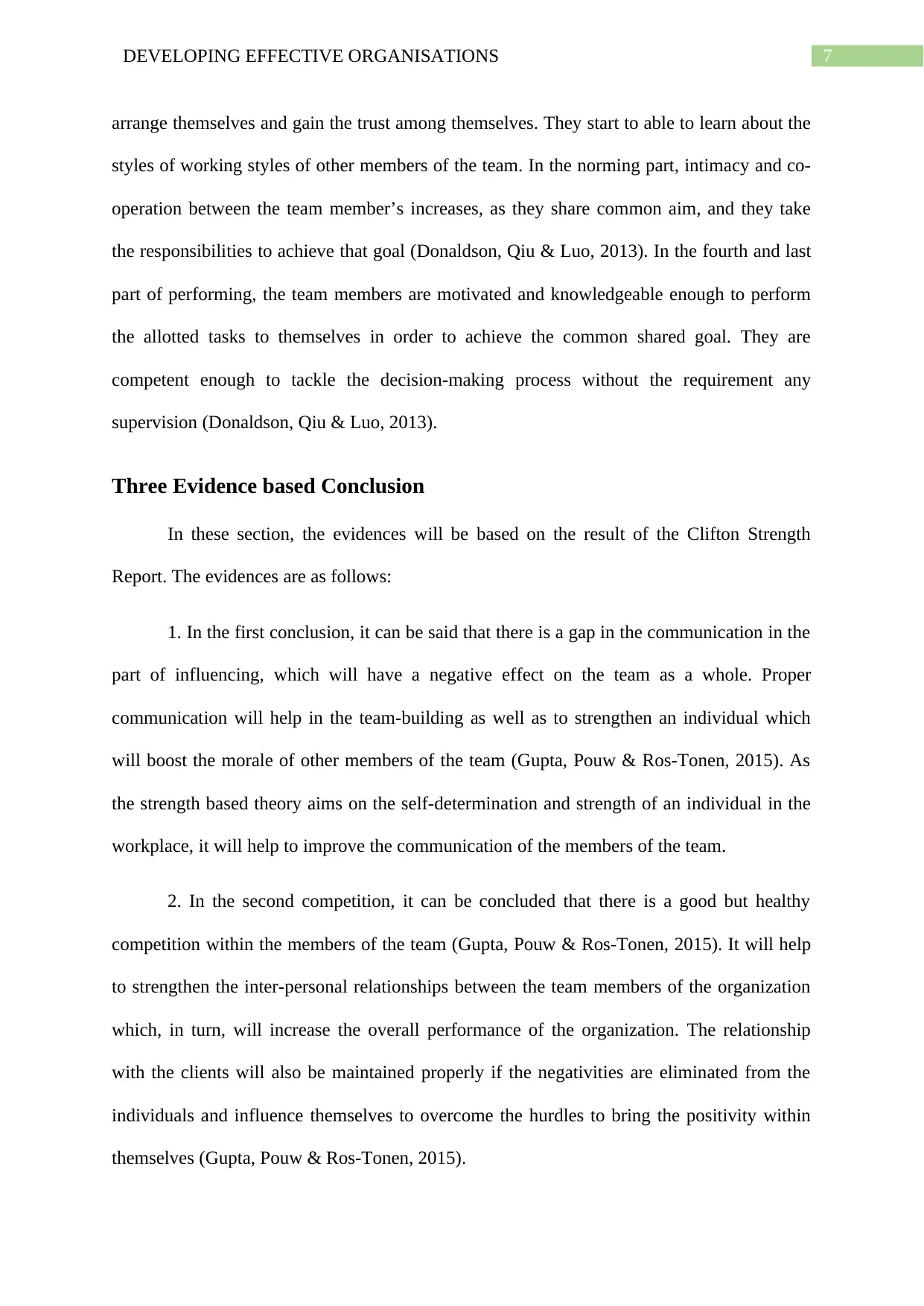
7DEVELOPING EFFECTIVE ORGANISATIONS
arrange themselves and gain the trust among themselves. They start to able to learn about the
styles of working styles of other members of the team. In the norming part, intimacy and co-
operation between the team member’s increases, as they share common aim, and they take
the responsibilities to achieve that goal (Donaldson, Qiu & Luo, 2013). In the fourth and last
part of performing, the team members are motivated and knowledgeable enough to perform
the allotted tasks to themselves in order to achieve the common shared goal. They are
competent enough to tackle the decision-making process without the requirement any
supervision (Donaldson, Qiu & Luo, 2013).
Three Evidence based Conclusion
In these section, the evidences will be based on the result of the Clifton Strength
Report. The evidences are as follows:
1. In the first conclusion, it can be said that there is a gap in the communication in the
part of influencing, which will have a negative effect on the team as a whole. Proper
communication will help in the team-building as well as to strengthen an individual which
will boost the morale of other members of the team (Gupta, Pouw & Ros-Tonen, 2015). As
the strength based theory aims on the self-determination and strength of an individual in the
workplace, it will help to improve the communication of the members of the team.
2. In the second competition, it can be concluded that there is a good but healthy
competition within the members of the team (Gupta, Pouw & Ros-Tonen, 2015). It will help
to strengthen the inter-personal relationships between the team members of the organization
which, in turn, will increase the overall performance of the organization. The relationship
with the clients will also be maintained properly if the negativities are eliminated from the
individuals and influence themselves to overcome the hurdles to bring the positivity within
themselves (Gupta, Pouw & Ros-Tonen, 2015).
arrange themselves and gain the trust among themselves. They start to able to learn about the
styles of working styles of other members of the team. In the norming part, intimacy and co-
operation between the team member’s increases, as they share common aim, and they take
the responsibilities to achieve that goal (Donaldson, Qiu & Luo, 2013). In the fourth and last
part of performing, the team members are motivated and knowledgeable enough to perform
the allotted tasks to themselves in order to achieve the common shared goal. They are
competent enough to tackle the decision-making process without the requirement any
supervision (Donaldson, Qiu & Luo, 2013).
Three Evidence based Conclusion
In these section, the evidences will be based on the result of the Clifton Strength
Report. The evidences are as follows:
1. In the first conclusion, it can be said that there is a gap in the communication in the
part of influencing, which will have a negative effect on the team as a whole. Proper
communication will help in the team-building as well as to strengthen an individual which
will boost the morale of other members of the team (Gupta, Pouw & Ros-Tonen, 2015). As
the strength based theory aims on the self-determination and strength of an individual in the
workplace, it will help to improve the communication of the members of the team.
2. In the second competition, it can be concluded that there is a good but healthy
competition within the members of the team (Gupta, Pouw & Ros-Tonen, 2015). It will help
to strengthen the inter-personal relationships between the team members of the organization
which, in turn, will increase the overall performance of the organization. The relationship
with the clients will also be maintained properly if the negativities are eliminated from the
individuals and influence themselves to overcome the hurdles to bring the positivity within
themselves (Gupta, Pouw & Ros-Tonen, 2015).
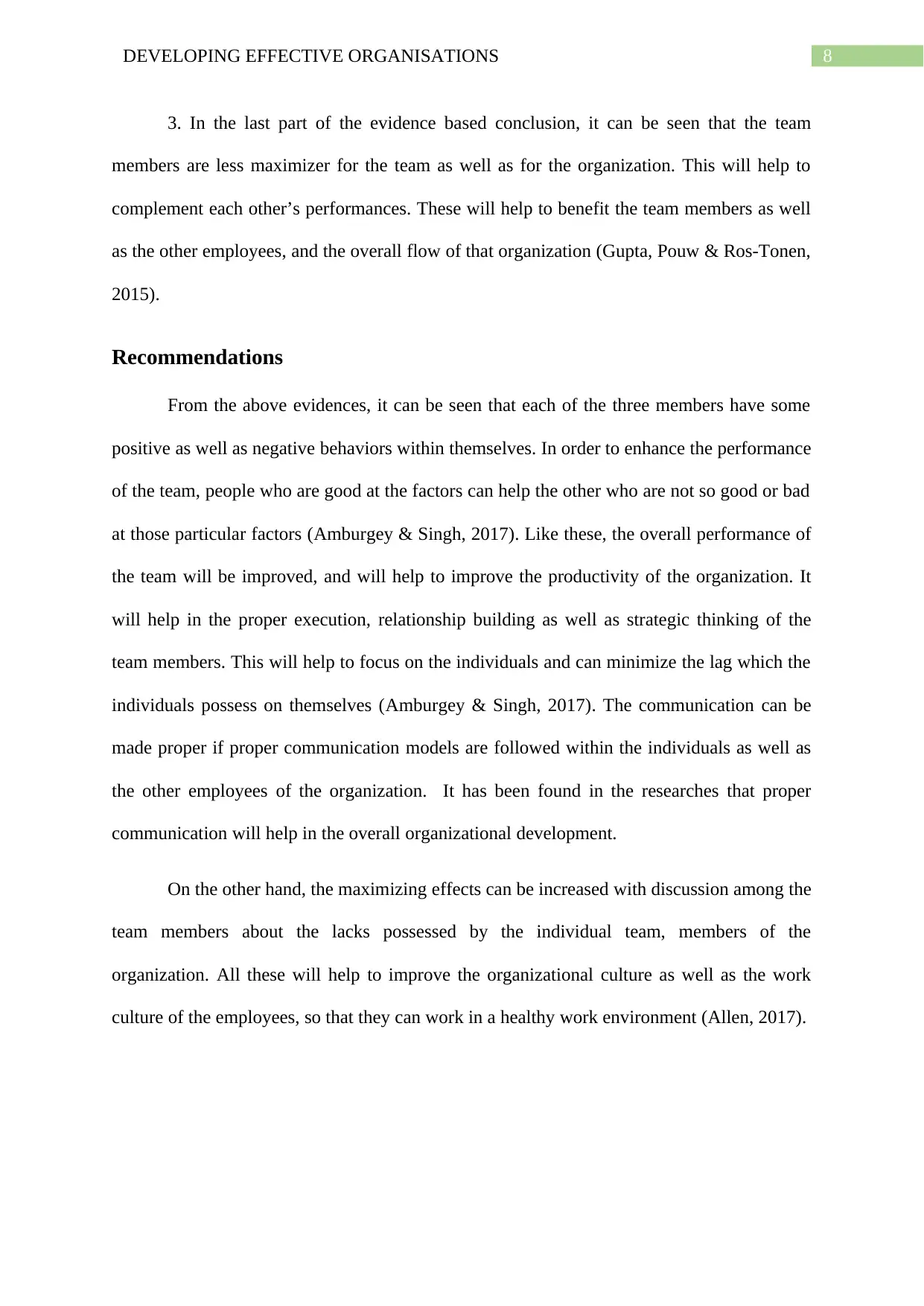
8DEVELOPING EFFECTIVE ORGANISATIONS
3. In the last part of the evidence based conclusion, it can be seen that the team
members are less maximizer for the team as well as for the organization. This will help to
complement each other’s performances. These will help to benefit the team members as well
as the other employees, and the overall flow of that organization (Gupta, Pouw & Ros-Tonen,
2015).
Recommendations
From the above evidences, it can be seen that each of the three members have some
positive as well as negative behaviors within themselves. In order to enhance the performance
of the team, people who are good at the factors can help the other who are not so good or bad
at those particular factors (Amburgey & Singh, 2017). Like these, the overall performance of
the team will be improved, and will help to improve the productivity of the organization. It
will help in the proper execution, relationship building as well as strategic thinking of the
team members. This will help to focus on the individuals and can minimize the lag which the
individuals possess on themselves (Amburgey & Singh, 2017). The communication can be
made proper if proper communication models are followed within the individuals as well as
the other employees of the organization. It has been found in the researches that proper
communication will help in the overall organizational development.
On the other hand, the maximizing effects can be increased with discussion among the
team members about the lacks possessed by the individual team, members of the
organization. All these will help to improve the organizational culture as well as the work
culture of the employees, so that they can work in a healthy work environment (Allen, 2017).
3. In the last part of the evidence based conclusion, it can be seen that the team
members are less maximizer for the team as well as for the organization. This will help to
complement each other’s performances. These will help to benefit the team members as well
as the other employees, and the overall flow of that organization (Gupta, Pouw & Ros-Tonen,
2015).
Recommendations
From the above evidences, it can be seen that each of the three members have some
positive as well as negative behaviors within themselves. In order to enhance the performance
of the team, people who are good at the factors can help the other who are not so good or bad
at those particular factors (Amburgey & Singh, 2017). Like these, the overall performance of
the team will be improved, and will help to improve the productivity of the organization. It
will help in the proper execution, relationship building as well as strategic thinking of the
team members. This will help to focus on the individuals and can minimize the lag which the
individuals possess on themselves (Amburgey & Singh, 2017). The communication can be
made proper if proper communication models are followed within the individuals as well as
the other employees of the organization. It has been found in the researches that proper
communication will help in the overall organizational development.
On the other hand, the maximizing effects can be increased with discussion among the
team members about the lacks possessed by the individual team, members of the
organization. All these will help to improve the organizational culture as well as the work
culture of the employees, so that they can work in a healthy work environment (Allen, 2017).
⊘ This is a preview!⊘
Do you want full access?
Subscribe today to unlock all pages.

Trusted by 1+ million students worldwide

9DEVELOPING EFFECTIVE ORGANISATIONS
References
Allen, N. J. (2017). Organizational commitment in the military: A discussion of theory and
practice. In Organizational Commitment in the Military (pp. 237-253). Psychology
Press.
Amburgey, T. L., & Singh, J. V. (2017). Organizational evolution. The Blackwell Companion
to Organizations, 327-343.
Bybee, J. L. (2013). Usage-based theory and exemplar representations of constructions.
In The Oxford handbook of construction grammar.
Donaldson, L., Qiu, J., & Luo, B. N. (2013). For rigour in organizational management theory
research. Journal of Management Studies, 50(1), 153-172.
Falkheimer, J. (2014). The power of strategic communication in organizational
development. International Journal of Quality and Service Sciences, 6(2/3), 124-133.
Francescato, D., & Aber, M. S. (2015). Learning from organizational theory to build
organizational empowerment. Journal of Community Psychology, 43(6), 717-738.
Fraussen, B. (2014). The visible hand of the state: On the organizational development of
interest groups. Public Administration, 92(2), 406-421.
Gerasimov, B. N., & Gerasimov, K. B. (2015). Modeling the development of organization
management system. Asian Social Science, 11(20), 82.
Gond, J. P., Cabantous, L., Harding, N., & Learmonth, M. (2016). What do we mean by
performativity in organizational and management theory? The uses and abuses of
performativity. International Journal of Management Reviews, 18(4), 440-463.
References
Allen, N. J. (2017). Organizational commitment in the military: A discussion of theory and
practice. In Organizational Commitment in the Military (pp. 237-253). Psychology
Press.
Amburgey, T. L., & Singh, J. V. (2017). Organizational evolution. The Blackwell Companion
to Organizations, 327-343.
Bybee, J. L. (2013). Usage-based theory and exemplar representations of constructions.
In The Oxford handbook of construction grammar.
Donaldson, L., Qiu, J., & Luo, B. N. (2013). For rigour in organizational management theory
research. Journal of Management Studies, 50(1), 153-172.
Falkheimer, J. (2014). The power of strategic communication in organizational
development. International Journal of Quality and Service Sciences, 6(2/3), 124-133.
Francescato, D., & Aber, M. S. (2015). Learning from organizational theory to build
organizational empowerment. Journal of Community Psychology, 43(6), 717-738.
Fraussen, B. (2014). The visible hand of the state: On the organizational development of
interest groups. Public Administration, 92(2), 406-421.
Gerasimov, B. N., & Gerasimov, K. B. (2015). Modeling the development of organization
management system. Asian Social Science, 11(20), 82.
Gond, J. P., Cabantous, L., Harding, N., & Learmonth, M. (2016). What do we mean by
performativity in organizational and management theory? The uses and abuses of
performativity. International Journal of Management Reviews, 18(4), 440-463.
Paraphrase This Document
Need a fresh take? Get an instant paraphrase of this document with our AI Paraphraser

10DEVELOPING EFFECTIVE ORGANISATIONS
Gupta, J., Pouw, N. R., & Ros-Tonen, M. A. (2015). Towards an elaborated theory of
inclusive development. The European Journal of Development Research, 27(4), 541-
559.
Harvey, P., Madison, K., Martinko, M., Crook, T. R., & Crook, T. A. (2014). Attribution
theory in the organizational sciences: The road traveled and the path ahead. Academy
of Management Perspectives, 28(2), 128-146.
Huang, L., & Knight, A. P. (2017). Resources and relationships in entrepreneurship: an
exchange theory of the development and effects of the entrepreneur-investor
relationship. Academy of Management Review, 42(1), 80-102.
Kurtessis, J. N., Eisenberger, R., Ford, M. T., Buffardi, L. C., Stewart, K. A., & Adis, C. S.
(2017). Perceived organizational support: A meta-analytic evaluation of
organizational support theory. Journal of management, 43(6), 1854-1884.
MacKie, D. (2014). The effectiveness of strength-based executive coaching in enhancing full
range leadership development: A controlled study. Consulting Psychology Journal:
Practice and Research, 66(2), 118.
Meyers, M. C., & Van Woerkom, M. (2014). The influence of underlying philosophies on
talent management: Theory, implications for practice, and research agenda. Journal
of World Business, 49(2), 192-203.
Morgeson, F. P., Mitchell, T. R., & Liu, D. (2015). Event system theory: An event-oriented
approach to the organizational sciences. Academy of Management Review, 40(4), 515-
537.
Gupta, J., Pouw, N. R., & Ros-Tonen, M. A. (2015). Towards an elaborated theory of
inclusive development. The European Journal of Development Research, 27(4), 541-
559.
Harvey, P., Madison, K., Martinko, M., Crook, T. R., & Crook, T. A. (2014). Attribution
theory in the organizational sciences: The road traveled and the path ahead. Academy
of Management Perspectives, 28(2), 128-146.
Huang, L., & Knight, A. P. (2017). Resources and relationships in entrepreneurship: an
exchange theory of the development and effects of the entrepreneur-investor
relationship. Academy of Management Review, 42(1), 80-102.
Kurtessis, J. N., Eisenberger, R., Ford, M. T., Buffardi, L. C., Stewart, K. A., & Adis, C. S.
(2017). Perceived organizational support: A meta-analytic evaluation of
organizational support theory. Journal of management, 43(6), 1854-1884.
MacKie, D. (2014). The effectiveness of strength-based executive coaching in enhancing full
range leadership development: A controlled study. Consulting Psychology Journal:
Practice and Research, 66(2), 118.
Meyers, M. C., & Van Woerkom, M. (2014). The influence of underlying philosophies on
talent management: Theory, implications for practice, and research agenda. Journal
of World Business, 49(2), 192-203.
Morgeson, F. P., Mitchell, T. R., & Liu, D. (2015). Event system theory: An event-oriented
approach to the organizational sciences. Academy of Management Review, 40(4), 515-
537.
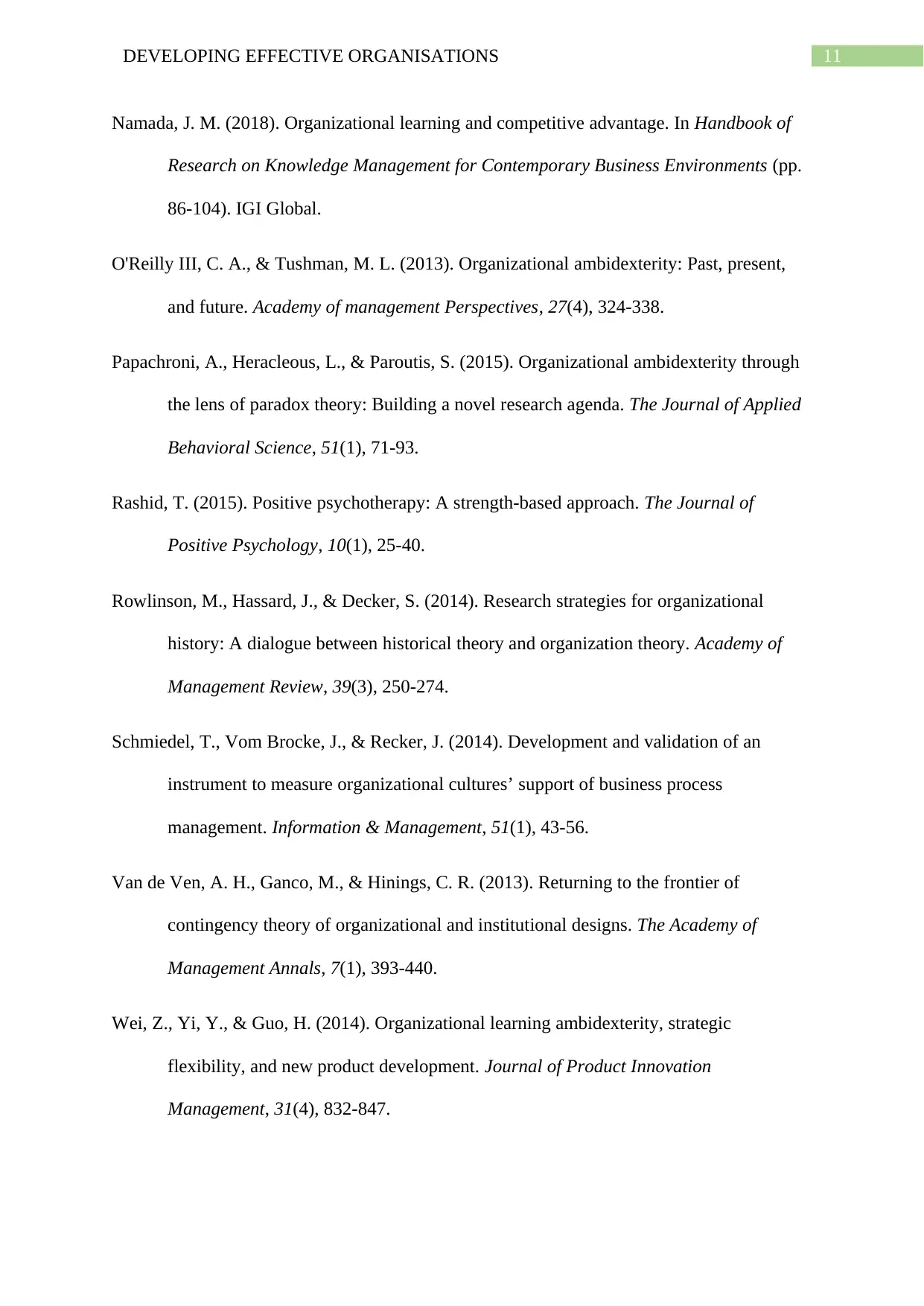
11DEVELOPING EFFECTIVE ORGANISATIONS
Namada, J. M. (2018). Organizational learning and competitive advantage. In Handbook of
Research on Knowledge Management for Contemporary Business Environments (pp.
86-104). IGI Global.
O'Reilly III, C. A., & Tushman, M. L. (2013). Organizational ambidexterity: Past, present,
and future. Academy of management Perspectives, 27(4), 324-338.
Papachroni, A., Heracleous, L., & Paroutis, S. (2015). Organizational ambidexterity through
the lens of paradox theory: Building a novel research agenda. The Journal of Applied
Behavioral Science, 51(1), 71-93.
Rashid, T. (2015). Positive psychotherapy: A strength-based approach. The Journal of
Positive Psychology, 10(1), 25-40.
Rowlinson, M., Hassard, J., & Decker, S. (2014). Research strategies for organizational
history: A dialogue between historical theory and organization theory. Academy of
Management Review, 39(3), 250-274.
Schmiedel, T., Vom Brocke, J., & Recker, J. (2014). Development and validation of an
instrument to measure organizational cultures’ support of business process
management. Information & Management, 51(1), 43-56.
Van de Ven, A. H., Ganco, M., & Hinings, C. R. (2013). Returning to the frontier of
contingency theory of organizational and institutional designs. The Academy of
Management Annals, 7(1), 393-440.
Wei, Z., Yi, Y., & Guo, H. (2014). Organizational learning ambidexterity, strategic
flexibility, and new product development. Journal of Product Innovation
Management, 31(4), 832-847.
Namada, J. M. (2018). Organizational learning and competitive advantage. In Handbook of
Research on Knowledge Management for Contemporary Business Environments (pp.
86-104). IGI Global.
O'Reilly III, C. A., & Tushman, M. L. (2013). Organizational ambidexterity: Past, present,
and future. Academy of management Perspectives, 27(4), 324-338.
Papachroni, A., Heracleous, L., & Paroutis, S. (2015). Organizational ambidexterity through
the lens of paradox theory: Building a novel research agenda. The Journal of Applied
Behavioral Science, 51(1), 71-93.
Rashid, T. (2015). Positive psychotherapy: A strength-based approach. The Journal of
Positive Psychology, 10(1), 25-40.
Rowlinson, M., Hassard, J., & Decker, S. (2014). Research strategies for organizational
history: A dialogue between historical theory and organization theory. Academy of
Management Review, 39(3), 250-274.
Schmiedel, T., Vom Brocke, J., & Recker, J. (2014). Development and validation of an
instrument to measure organizational cultures’ support of business process
management. Information & Management, 51(1), 43-56.
Van de Ven, A. H., Ganco, M., & Hinings, C. R. (2013). Returning to the frontier of
contingency theory of organizational and institutional designs. The Academy of
Management Annals, 7(1), 393-440.
Wei, Z., Yi, Y., & Guo, H. (2014). Organizational learning ambidexterity, strategic
flexibility, and new product development. Journal of Product Innovation
Management, 31(4), 832-847.
⊘ This is a preview!⊘
Do you want full access?
Subscribe today to unlock all pages.

Trusted by 1+ million students worldwide
1 out of 13
Related Documents
Your All-in-One AI-Powered Toolkit for Academic Success.
+13062052269
info@desklib.com
Available 24*7 on WhatsApp / Email
![[object Object]](/_next/static/media/star-bottom.7253800d.svg)
Unlock your academic potential
Copyright © 2020–2025 A2Z Services. All Rights Reserved. Developed and managed by ZUCOL.





